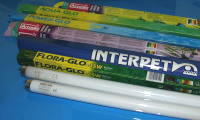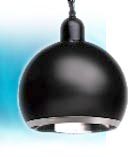|
|
Aquarium Lighting
|
The lighting used in an aquarium is governed to a large extent by whether the tank is to contain live plants.
If the tank will not contain plants (or only plastic plants) then the light need only provide a means to
view the fish. The choice of lighting is then only governed by choosing a light which enhances the colours
of fish. A light intensity of around 10W per square foot of water surface area is sufficient for this
purpose (e.g. a 40W fluorescent tube for a tank with a base measuring 48x12"). With LED lighting, around half this wattage will be sufficient.
|
|
For many years, fluorescent tubes have been the most commonly used form of lighting in aquariums, but they are now being overtaken by LED units.
Flourescent tubes are available in a range of sizes and colour spectrums to suit different tanks and applications. The "standard" fluorescent tube for aquarium use has
previously been the "T8" tube - meaning eight-eighths (8/8) of an inch or 1" diameter. In more recent years, T5 tubes that
are 5/8" diameter have become popular. These are generally brighter for a given length than T8 tubes, so are particularly popular for
taller tanks and planted tanks where more intense lighting is desired, and were becoming standard in many popular commercial tank brands before the arrival of LEDs.
|
 |
|
Fluorescent tubes suitable for fish-only tanks or tanks containing plants with a low light requirement are generally those
described as warm white. These include Hagen's Sunglo, Arcadia's Tropical tube and the Juwel Warm-Lite.
These give the aquarium a "warmer" appearance than some higher intensity "daylight" or "full spectrum" white lights, which can give a
bleached-out look in certain setups.
|
|
Planted tanks need more light than fish only tanks, and the type of lighting becomes more important. The
light requirement of different plant species varies somewhat, but generally the light will need to be at
least double that recommended for a fish only tank, i.e. 20W per square foot of tank surface area. Light
requirements are also quoted per volume, e.g. 2W per gallon. A number of manufacturers produce fluorescent
tubes designed to provide maximum plant growth. These include Arcadia's Freshwater tube, Hagen's Lifeglo and the Juwel Day-Lite.
|
|
For heavily planted tanks, it was once common to employ metal halide or mercury vapour lights, which were normally
suspended above an open-top tank. These are able to punch light deeper than fluorescent tubing and are
therefore useful for tanks 24"/60cm or more high. However, these have now been largely replaced by high-intensity LED units.
It should be remembered that when higher intensity lighting is employed to boost plant growth, it will be necessary to balance this
with an adequate amount of nutrients and CO2.
|
 |
|
The recent change in the lighting available for aquariums towards LED lighting has brought a number of advantages. Although still relatively expensive,
LED lighting offers longer life, lower wattage (and hence running costs), compact designs and more flexibility - including such innovations as user-programmable
intensity, spectral output and gradual ramping up and down for dawn and dusk effects. LED's also offer "point source" lighting that gives a pleasant shimmer to the water
(like metal halides) - an effect not seen with the "flat" light from a fluorescent tube.
|
[Home]
[Article Library]
[Fish Index]
[Tank Setups]
[Forum]
[Site Map]
|
|
|




